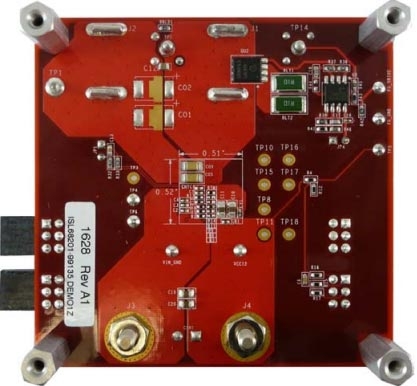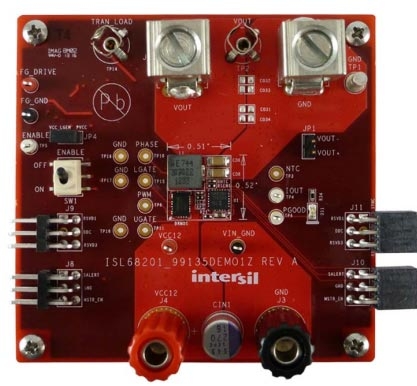Overview
Description
The ISL68201-99135DEMO1Z is a 6-layer board used to demonstrate a compact 13mm x 13mm 20A synchronous buck converter. Transient performance, fault protections, DC/AC regulations, PMBus programming, power sequencing, margining, and other features can be evaluated using this board.
The ISL68201 is a single-phase synchronous buck PWM controller featuring Renesas' proprietary R4™ Technology, which has extremely fast transient performance, accurately regulated frequency control and all internal compensation. The ISL68201 supports a wide 4.5V to 24V input voltage range and a wide 0.5V to 5.5V output range. It includes programmable functions and telemetries for easy use and high system flexibility using an SMBus, PMBus or I2C interface.
The ISL99135B is a DrMOS power stage compatible with Renesas' 5V PWM controllers (such as ISL6398, ISL637x, ISL633x, ISL636x, ISL9585x, and ISL68201). They use a DCR sensing network and associated thermal compensation. Light-load efficiency is supported via a dedicated FCCM control pin. An industry-leading thermally enhanced 3.5 x 5 QFN 24 Ld package allows minimal overall PCB real estate.
The PMBus dongle (ISLUSBEVAL1Z), i.e., USB-to-PMBus™ adapter, and USB cable are included in the demonstration kit. Download the PowerNavigator™ software to evaluate the full PMBus functionality of the ISL68201.
Features
- 16A synchronous buck converter with PMBus control
- On-board transient load with adjustable di/dt
- Configurable through resistor pins
- Cascadable PMBus connectors
- Integrated LDOs for single rail solution
- Enable switch and power-good indicator
- All ceramics solution with SP capacitor footprint option
Applications
- High-efficiency and high-density VRM and VRD
- Core, graphic and memory regulators for microprocessors
- High-density VR for server, networking and cloud computing
- POL DC/DC converters and video gaming consoles
Documentation
|
|
|
|
|---|---|---|
| Type | Title | Date |
| Manual - Development Tools | PDF 1.95 MB | |
| Datasheet | PDF 1.68 MB 日本語 | |
| Manual - Development Tools | PDF 257 KB | |
| Guide | PDF 4.68 MB | |
| Guide | PDF 714 KB | |
| Datasheet | PDF 840 KB | |
6 items
|
||
Design & Development
Software & Tools
Software & Tools
| Software title
|
Software type
|
Company
|
|---|---|---|
| PowerNavigator Software Renesas' PowerNavigator™ software allows simple configuration and monitoring of multiple Digital-DC devices using a PC with a USB interface.
|
Monitor Debugger/RAM Monitor | Renesas |
1 item
|
||
Product Options
Applied Filters:
Videos & Training
These PMBus™ compatible single-phase digital hybrid DC/DC controllers are ideal for point-of-load (POL) conversions. They support a wide range of applications, including FPGAs, DSPs, ASICs, processors, and general-purpose system rails.
The ISL68200 model is integrated with MOSFET drivers, making power supply design simpler. The ISL68201 features a PWM output for efficient performance. Both models are designed to meet the demands of data centers and wireless infrastructure applications.
Transcript
Digital Hybrid PWM Controllers with PMBus
Hello, my name is Brandon Howell, Product Marketing Manager for Intersil's digital power products. Today, I'm excited to be introducing the new family of digital power products from Intersil, our hybrid digital controllers. In this family, we have two versions, the ISL68200 and the ISL68201. Before we dive into those, I'd like to go through the difference between an analog controller, a hybrid digital controller, and a full digital controller.
Intersil Digital Hybrid PMBus Controllers
An analog controller uses an analog control loop, typically, voltage mode or current mode. A hybrid digital controller uses Intersil's proprietary R4 control loop. A full digital controller, on the other hand, would use a full digital loop, such as charge mode control.
Hybrid digital controllers offer a PMBus interface with less than 25 commands, while a full digital control loop would have a more full-featured PMBus command interface with 100-plus commands. Analog controllers offer no PMBus interface.
Supply telemetry, including VIN, VOUT, IOUT temperature, is included with these hybrid digital controllers, while a full digital controller would have additional telemetry such as duty cycles, switching frequency, and black box capability.
Hybrid digital controllers are fully configurable with external resistors, so there's no need for any nonvolatile memory, and have a very similar design flow to a typical analog controller. Full digital controllers, on the other hand, typically require a nonvolatile memory and configuration files.
ISL68200/1 Digital Hybrid PMBus Controllers
In this family, we have two controllers, the ISL68200 and the ISL68201. The ISL68200 has integrated drivers allowing you to prepare it with external MOSFETs. The ISL68201 has a PWM output allowing you to prepare it with a DrMOS or a similar power stage. Both controllers have a 4.5V to 24V input range, a .5V to 5.5V output range, a 300kHz to 1.5MHz switching frequency range, and Intersil's proprietary compensation-free R4 modulator. R4 offers fast transient performance and built-in light-load efficiency modes from improved efficiency at light-load currents.
The controller does not require any nonvolatile memory, and it's fully configurable with external pin-strap resistors. The PMBus interface can be used for supply telemetry including VIN, VOUT, IOUT temperature, fault reporting, and on the fly VOUT margin of the output voltage.
Both controllers come in a space-saving 4mm x 4 mm, 28-lead QFN package. Looking at our hybrid digital controllers there are three main features that differentiate them in the market. The first is ease of use. Because the R4 modulator is compensation-free, there is no need for external compensation. This also means the end-user does not have to worry about compensating their design. The modulator is inherently stable. It is also a very fast, operating incredibly fast transient performance and built-in light-load efficiency modes. The PMBus interface is optional, but it offers flexibility, including on the fly configuration changes, supply telemetry, and VOUT margin capability.
Key Differentiation: R4 Modulator
One of the things that makes the ISL68200 and ISL68201 revolutionary is the R4 modulator using these devices. R4 is based on a current mode hysteretic control loop, and it offers inherent stability. The R4 control loop is inherently stable with optional digitally adjustable gain through the PMBus interface.
The main benefits of the R4 control loop include exceptionally high control loop bandwidth, inherently stable architecture, the ability to adjust both switching frequency and duty cycle response to a low transient, and seamless PFM to PWM transition, offering excellent light-load efficiency when this mode is enabled.
To showcase the performance of the R4 modulator, we benchmarked it against the constant on-time controller, a popular modulator on the market. On the left-hand side is the R4 control loop. Channel one is the upward voltage. Channel two is the load step. And channel three is the switch node. On the right-hand side is a similarly configured constant on-time controller from a competitor. Both have the same load step applied, have the same output capacitors and same output inductor, the only difference being the controller. The R4 control loop, because it can adjust both switching frequency and duty cycle, had one-half the output deviation as the constant on-time controller, all this due to the exceptionally fast transient performance that R4 offers.
Summary
Target application for the ISL68200 and 68201 include wired infrastructure, wireless infrastructure, data center, including servers and storage, FPGA, and high-end ASIC applications. The ISL68200 and 68201 represent a new family of hybrid digital controllers for Intersil. They offer the flexibility of a digital PMBus interface with the simplicity of analog control. The R4 control loop offers industry-leading transient performance, reducing the number of output caps needed versus competing products. Full power navigator support makes these products extremely easy to use. And we'll explore that in some future videos.
For more information on this product, please see the product information page.





